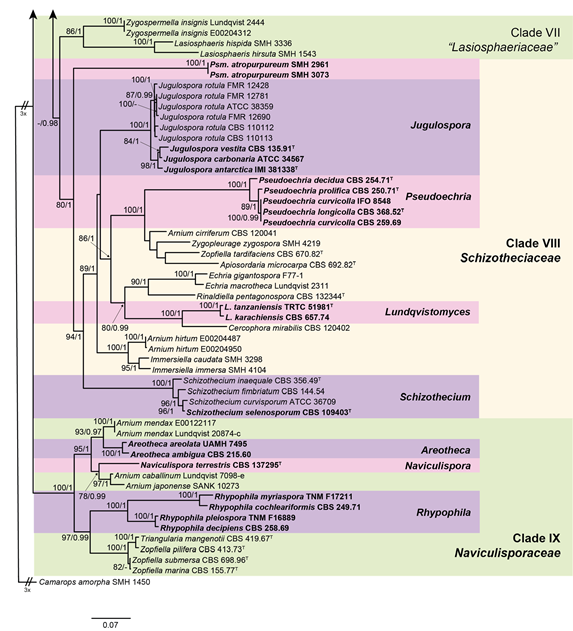Rhypophila Y. Marín, A.N. Mill. & Guarro, in Marin-Felix, Miller, Cano-Lira, Guarro, García, Stadler, Huhndorf & Stchigel, Microorganisms 8(9, no. 1430): 16 (2020)
Index Fungorum number: IF 812130; Facesoffungi number: FoF 14644
Etymology – Referring to the name of the section Rhypophila of the genus Podospora, proposed by Lundqvist (1972).
Type species – Rhypophila myriospora (P. Crouan & H. Crouan) Y. Marín, A.N. Mill. & Guarro.
Sexual morph Ascomata ostiolate, semi-immersed or superficial, scattered or aggregated, pyriform, glabrous or covered with flexuous or stiff hairs; neck long, conical or cylindrical, with blackish, obtuse, straight or curved, elongate tuberculated projections at the base. Ascomatal wall membranaceous, semi-translucent, yellowish to light brown. Paraphyses absent or present. Asci unitunicate, 8- to 128-spored, clavate, long or short stipitate, apical ring absent or indistinct. Ascospores biseriate or irregularly arranged, at first one-celled, hyaline, cylindrical or spatuliform, clavate, later swelling above, becoming transversely uniseptate and two-celled; upper cell dark brown, ellipsoidal to ellipsoidal-fusiform, with an apical or subapical germ pore; lower cell hyaline, cylindrical to cylindrical-obclavate, same length or longer than upper cell, frequently collapsing; secondary appendages small, at the base of the lower cell; apical gelatinous cauda absent or present, fibrillate or lamellate. Asexual morph absent.
Notes – Rhypophila includes species formerly classified in a section with the same name in the genus Podospora. Chang et al. also noted that Podospora species of the section Rhypophila grouped together in the phylogenies based on ITS and a fragment of the glyceraldehyde-3-phosphate dehydrogenase (gpd) gene. Although the phylogenetic distance between R. cochlearifomis/R. myriaspora and R. decipiens/R. pleiospora suggests that these could represent two different genera, we decided to include all these species in Rhypophila based on the morphological resemblances. Further studies, including more taxa, are needed to clarify it. The genus Rhypophila is characterized by the production of ostiolate ascomata with a neck bearing elongated tuberculated projections at the base, asci normally containing more than eight ascospores, and ascospores with a lower cell as long as, or longer than, the upper cell. Ornamentation in the upper part of the ascomata is also present in Pseudoechria, Pseudoschizothecium, and Schizothecium, but these three genera, classified in the new family Schizotheciaceae (clade VIII, Figure 2), differ in the nature of the ornamentation (see Notes on Pseudoechria).

Figure 2. Second part of the RAxML phylogram obtained from the combined ITS, LSU, rpb2, and tub2 sequences of our isolates and selected strains belonging to the families Chaetomiaceae, Diplogelasinosporaceae, Lasiosphaeriaceae, Naviculisporaceae, Podosporaceae, Schizotheciaceae, and Sordariaceae. Camarops amorpha was used as an outgroup. Bootstrap support values ≥70/Bayesian posterior probability scores ≥0.95 are indicated along branches. Branch lengths are proportional to distance. Novelties and emended taxa are indicated in bold. Ex-epitype, ex-isotype, and ex-type strains of the different species are indicated with ET, IsoT, and T, respectively.

Figure 5. Morphology of Rhypophila. Ascoma. (A) Rhypophila pleiospora LyRS9223.1.
(B) Rhypophila myriospora CBS 115804. Elongated tubercles at the neck. (C) Rhypophila pleiospora LyRS9223.1. (D) Rhypophila myriospora CBS 115804. Asci. (E) Rhypophila decipiens LyRS8109.2. (F) Rhypophila pleiospora LyRS9223.1. Immatured ascospores. (G,H) Rhypophila decipiens LyRS8109.2. Different ascospore morphologies. (I) Rhypophila decipiens LyRS8109.2. (J) Rhypophila pleiospora LyRS9223.1. (K) Rhypophila myriospora CBS 115804. Bars: (A,B) = 100 µm; (C,D) = 15 µm; (E,F) = 25 µm; (G,H,J,K) = 10 µm; (I) = 20 µm.
Species
